Key takeaways:
- Minimalism emphasizes living intentionally by prioritizing experiences over material possessions, leading to emotional liberation.
- Benefits of minimalism include reduced decision fatigue, improved relationships through quality interactions, and a stronger appreciation for meaningful items.
- Starting minimalism involves decluttering spaces, evaluating consumption habits, and cultivating mindfulness to understand personal values.
- Practical tips for embracing minimalism include the “one in, one out” rule and the “30-day declutter challenge” to create a more intentional and fulfilling life.
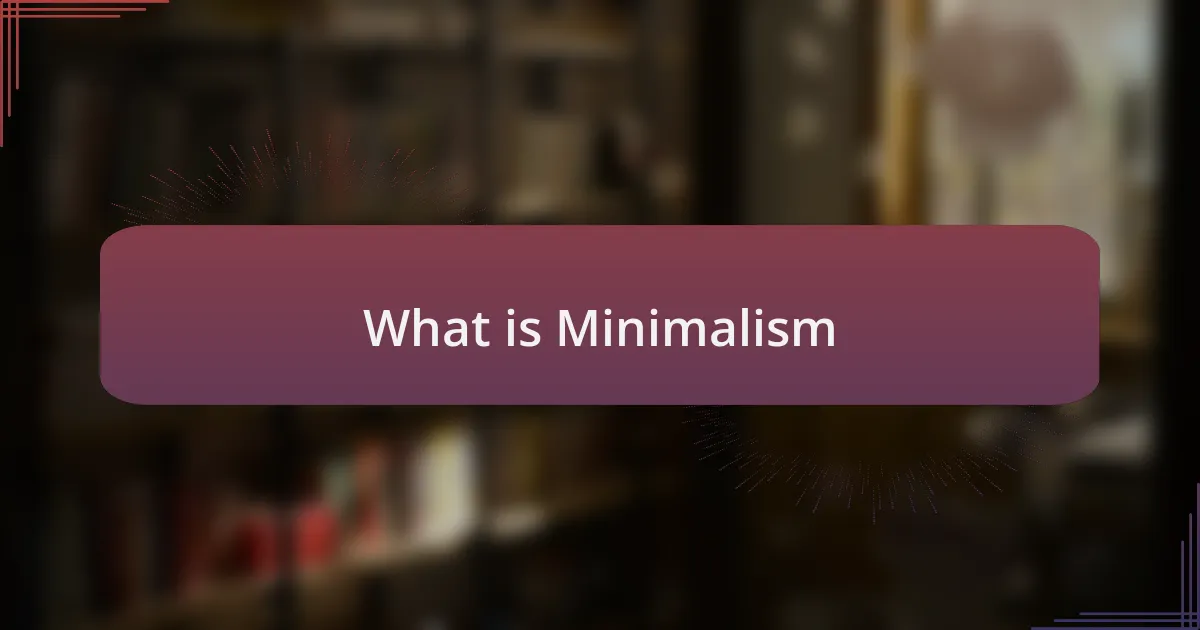
What is Minimalism
Minimalism is about living with intention, prioritizing experiences over possessions. I remember the moment I decided to declutter my space; I found that letting go of items I no longer used wasn’t just about physical space—it was incredibly liberating emotionally. Have you ever felt weighed down by things that no longer serve you?
At its core, minimalism encourages us to focus on what truly matters. For me, it was a shift from filling my home with knick-knacks to creating a serene environment that fosters creativity and mindfulness. I began asking myself, “Does this bring me joy?”—and it was astonishing how many things didn’t make the cut.
Ultimately, minimalism challenges us to assess our lives critically. I’ve learned that it’s not just about reducing clutter; it’s about enriching my daily life by steering clear of distractions. Isn’t it fascinating how a simple change in perspective can transform not only your space but also your mindset?
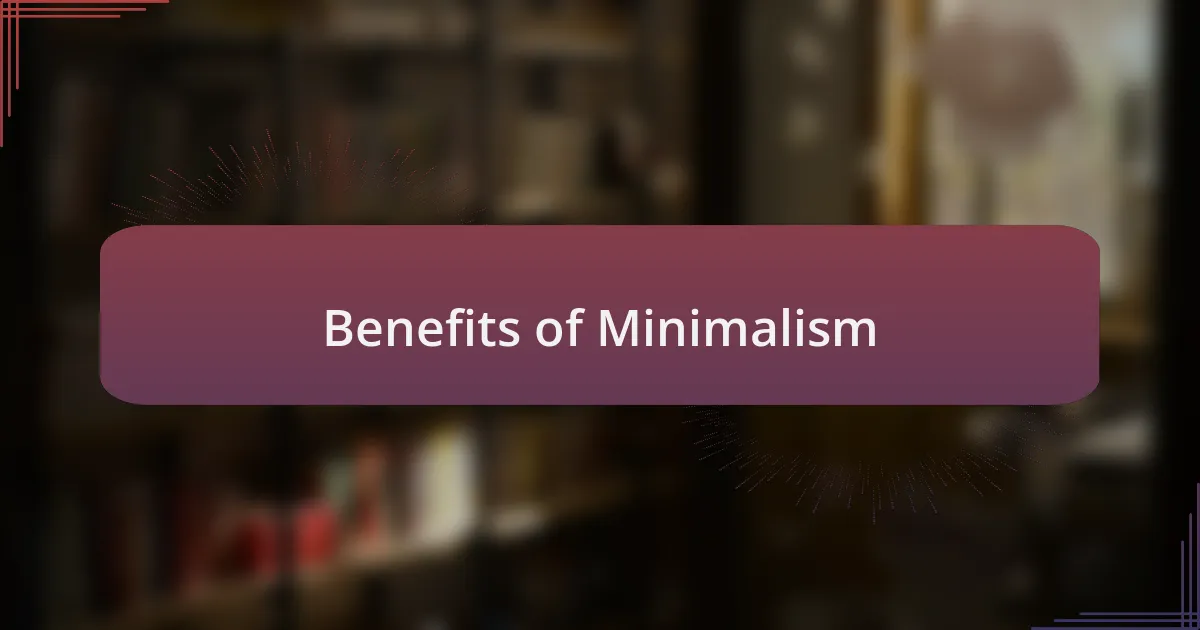
Benefits of Minimalism
Embracing minimalism has profoundly simplified my life, allowing me to focus on what truly matters. With fewer distractions, I can channel my energy into things that fuel my passions. This intentional way of living means I have more time to invest in experiences, be it a weekend hike or a quiet morning with a book. Have you ever considered how much mental peace can come from simplifying your surroundings?
Another key benefit I’ve noticed is the significant reduction in decision fatigue. By cutting down on choices—like what to wear or how to arrange my space—I find it easier to make decisions that truly matter. I remember the mornings when I’d stare at a cluttered closet, overwhelmed by options. Now, my streamlined wardrobe makes getting ready a breeze, giving me a sense of clarity and control over my day. How much easier could your mornings be with fewer distractions?
Minimalism also cultivates a deeper appreciation for quality over quantity. I’ve found joy in investing in a few well-crafted items rather than a multitude of cheaper, lesser-quality possessions. This shift has not only preserved my financial resources but also enriched my life with items I genuinely value. Have you ever thought about how the things you choose to keep can reflect who you are? Each piece I own now tells a story and serves a purpose, enhancing my overall sense of satisfaction.
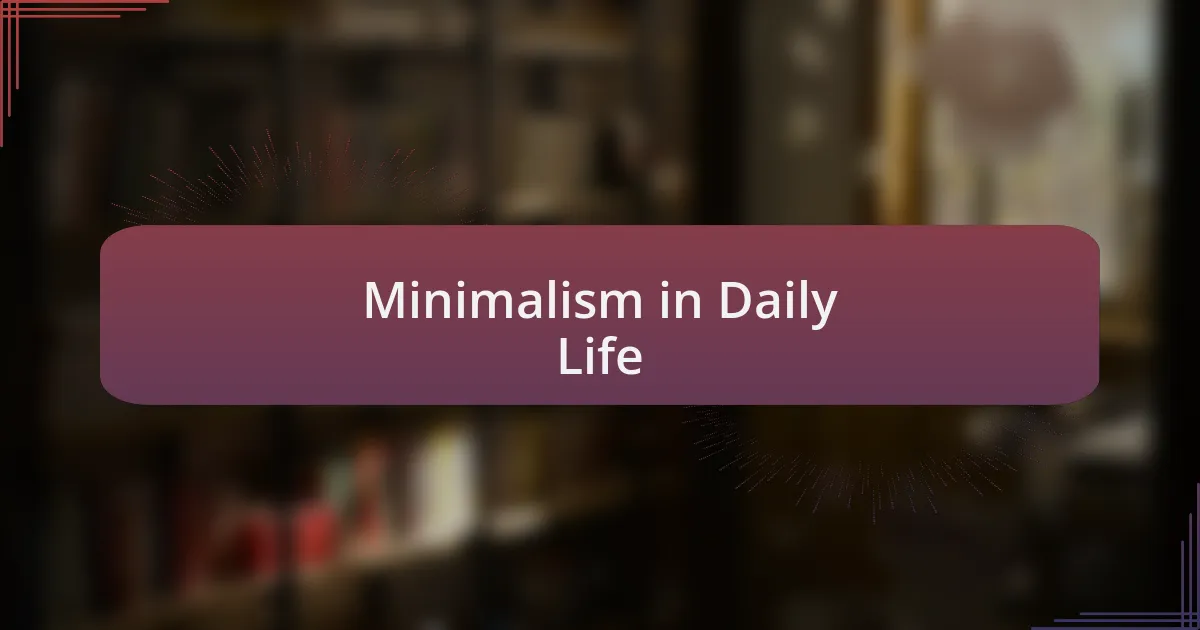
Minimalism in Daily Life
Engaging with minimalism every day has transformed how I approach my personal space and interactions. For instance, by decluttering my kitchen, I’ve created a serene cooking environment. Cooking feels less like a chore and more like an enjoyable experience, where I can focus on experimenting with flavors. How does your kitchen space influence your culinary creativity?
Social gatherings have also shifted in my minimalist journey. I’ve started to prioritize quality over quantity in my relationships, opting to spend time with a few close friends rather than a large crowd. During those intimate gatherings, I find deeper conversations emerge, allowing us to connect on a more meaningful level. It makes me wonder—do we sometimes overload our social calendars and miss out on cherished moments?
Another aspect I’ve embraced is minimalism in my daily routines. For example, I’ve simplified my morning rituals, focusing on just a few essential tasks that set a positive tone for the day. This might be as simple as enjoying a cup of tea in solitude or taking a few moments to stretch. It’s these small, intentional actions that create a ripple effect throughout my day. Have you ever noticed how even minor changes in your routine can lead to a greater sense of calm and productivity?
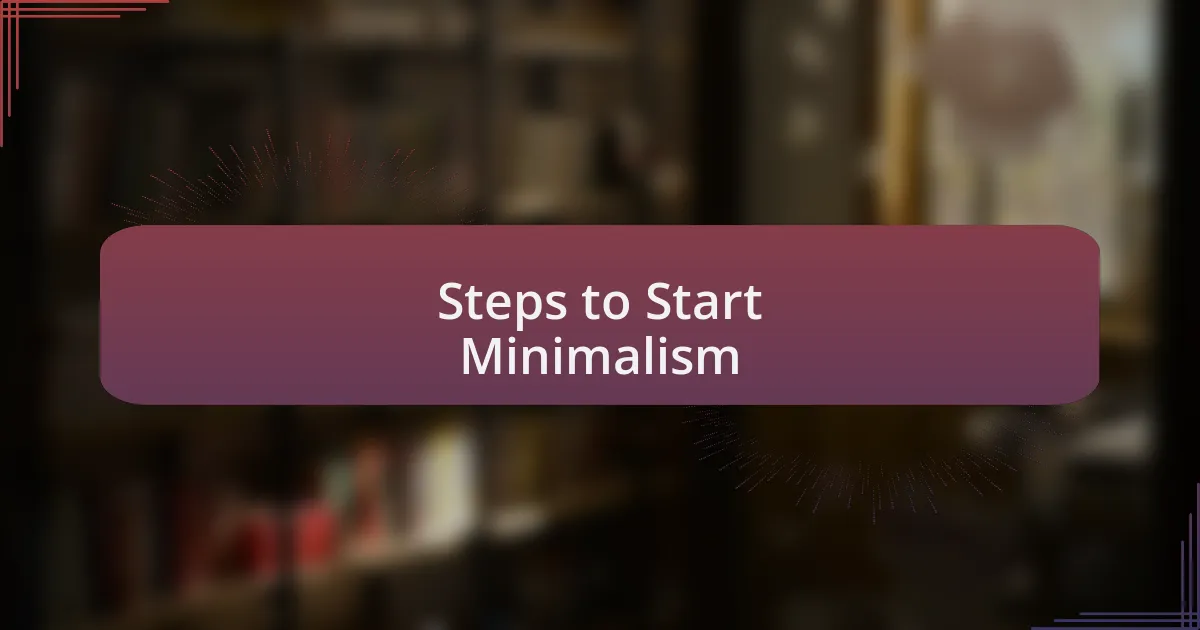
Steps to Start Minimalism
Beginning a minimalist journey can feel overwhelming, but taking it step by step makes it manageable. One of the first actions I took was to tackle my closet. I dedicated a weekend to sorting through my clothes, asking myself if each item brought me joy or served a purpose. This simple practice not only cleared physical space but also lifted a weight off my shoulders—have you ever felt the relief of letting go?
Another significant step is to evaluate how we consume information and material goods. I went through my bookshelves and removed titles I knew I’d never read again. It struck me how often we cling to things “just in case.” By creating a more curated collection, I discovered I actually enjoy the words that resonate with me. Have you considered how much of what you own could be let go without losing anything valuable?
Lastly, I found that cultivating mindfulness played a vital role in my transition. Setting aside a few moments daily for reflection helped me understand what I truly value. This might involve journaling or simply sitting in silence. It’s surprising how much clarity can emerge when we take time to listen to ourselves—what insights do you think await you in those quiet moments?
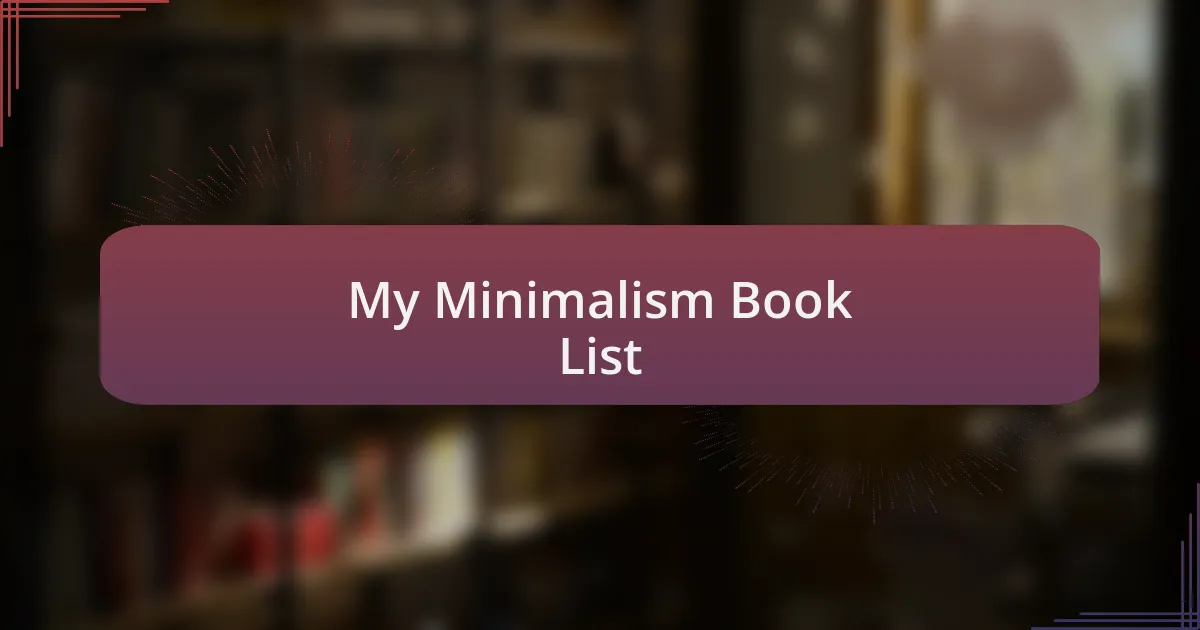
My Minimalism Book List
My journey into minimalism wouldn’t be complete without discussing my minimalism book list. The first title that stands out is “The Life-Changing Magic of Tidying Up” by Marie Kondo. When I read it, I was moved by her approach of surrounding oneself with items that spark joy. It struck me deeply; I remember holding onto a tattered book simply because it was a gift, but realizing it didn’t bring me any happiness. Have you ever held onto something out of obligation rather than affection?
Another essential read for me was “Essentialism: The Disciplined Pursuit of Less” by Greg McKeown. This book reshaped my mindset about priorities. I found it enlightening when McKeown discussed how being busy doesn’t equate to being productive. There was a moment in my life when my schedule overflowed, yet my achievements felt trivial. I often wondered, in that chaos, how many essential tasks slipped through the cracks?
Lastly, “Digital Minimalism” by Cal Newport opened my eyes to the clutter in my online life. After engrossing myself in the text, I decided to declutter my digital devices—deleting unused apps and unfollowing accounts that didn’t enrich my life. The lightness was palpable, yet it also begged me to ask: how much of our time do we waste scrolling when we could be savoring life? Each of these books not only influenced my perspective but also fostered tangible changes that continue to shape my journey.
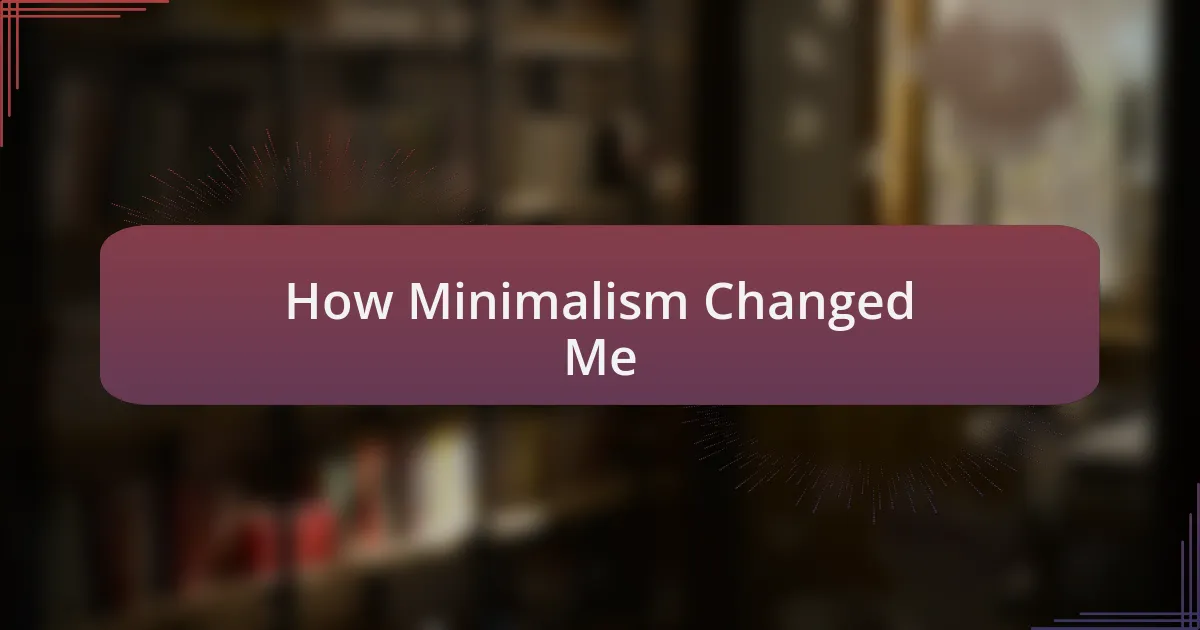
How Minimalism Changed Me
Embracing minimalism has profoundly shifted how I view my surroundings and myself. For instance, I used to have a closet overflowing with clothes that I rarely wore, each piece a reminder of past trends or impulses. The act of donating half of my wardrobe felt freeing; I remember standing in front of the empty space and experiencing a rush of clarity as if a weight had been lifted.
Another major change came with my approach to relationships. I realized that just as I was decluttering my physical space, I needed to do the same emotionally. There’s a specific friend whose constant negativity drained me, and choosing to step back from that relationship was tough. Have you ever had to distance yourself from someone who doesn’t uplift you? The relief I felt afterward was immense, reinforcing my commitment to surround myself with positivity.
Finally, minimalism has recalibrated my perspective on time. I found myself obsessively scheduling every minute of my day, yet it often led to burnout. Learning to say no to commitments that don’t align with my values has allowed me the space to genuinely enjoy simple pleasures, like a quiet evening with a good book. Isn’t it fascinating how prioritizing less can lead to more fulfilling moments?
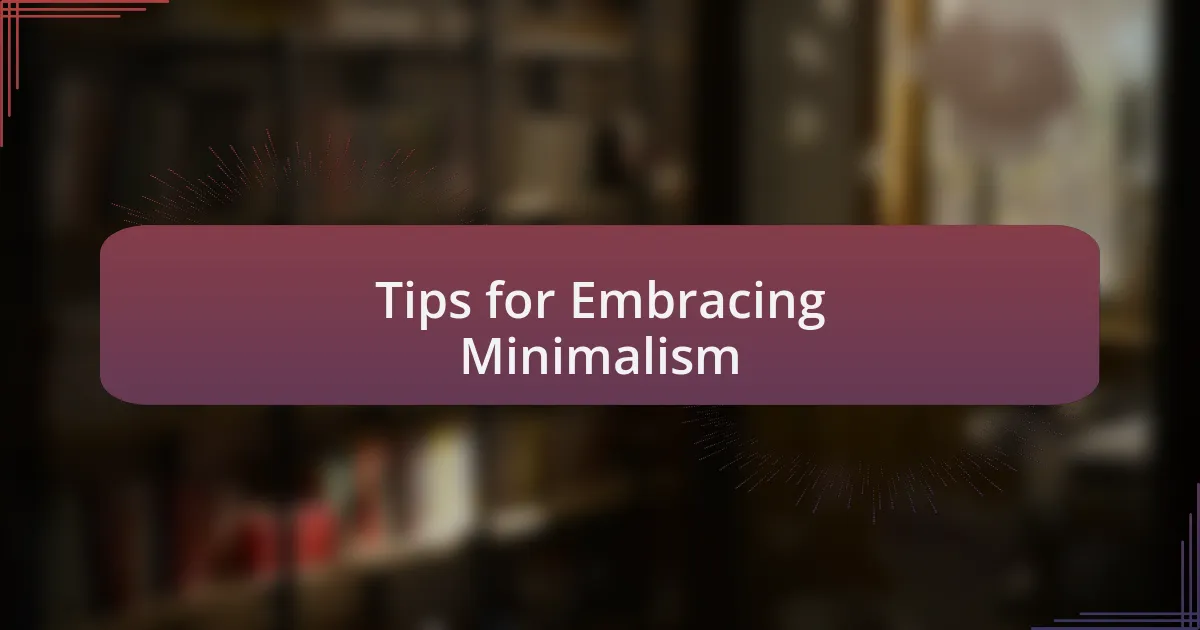
Tips for Embracing Minimalism
When I first ventured into minimalism, one tip that resonated deeply with me was the “one in, one out” rule. This approach not only helped me manage my belongings but also forced me to evaluate the importance of each item I brought into my home. Have you ever thought about how much easier your life would be if you granted each new purchase the same scrutiny? After a few months, I found myself more intentional about my choices.
Another practice I adopted was the “30-day declutter challenge.” The idea is simple: tackle one area of your home each day for a month. I recall the day I worked on my kitchen; it felt almost meditative as I sorted through old utensils and expired spices. Each item I let go of created a sense of liberation. Have you tried a similar challenge? The clarity gained from seeing my kitchen transform was nothing short of energizing.
One crucial insight I gathered through this journey is that minimalism extends beyond physical items; it encompasses mental clutter too. As I began to simplify my surroundings, I also found value in journaling my thoughts. Writing down worries or distractions was surprisingly cathartic, allowing me to release what no longer served me. Have you ever journaled to clear your mind? This practice not only helped me focus but also cultivated a deeper appreciation for the simplicity in both my environment and mindset.